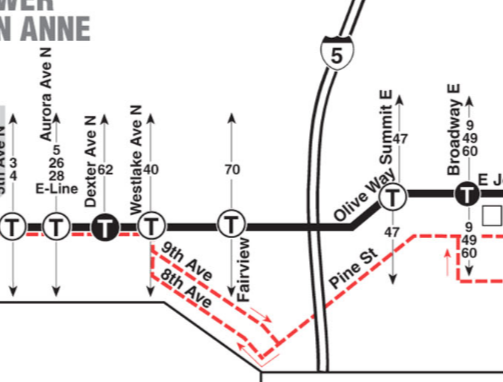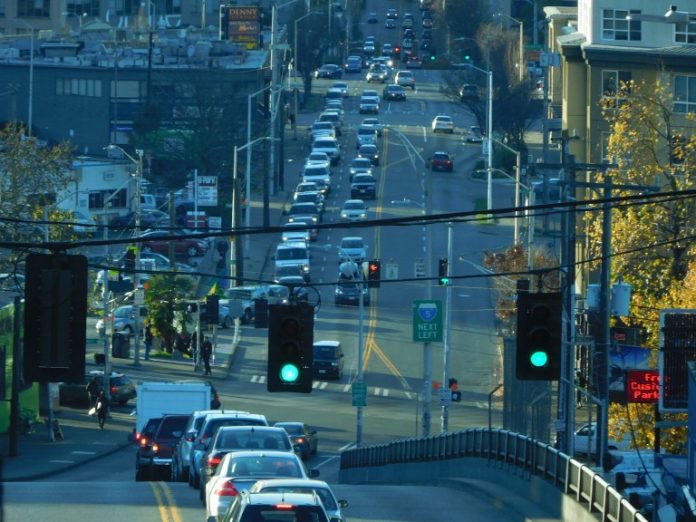As part of the ongoing work around the creation of Seattle City Light’s $300 million substation at Denny Way and Minor Ave N, closures on Denny Way have been occurring on nights and weekends for a few weeks. But the project is about to enter a new phase, with a big impact to travelers though South Lake Union and Denny Triangle.
From Seattle City Light:
From Friday, Oct. 14, at 11 p.m., to Monday, Oct. 17, at 5 a.m., all lanes on Denny Way will be closed while crews restripe the roadway. After 5 a.m. on Monday, Oct. 17, Denny Way between Stewart St. and Minor Ave N will be reduced to one lane in each direction 24 hours per day, 7 days a week, for five weeks. On the weekend ofNov. 19 and 20, crews will close all lanes of Denny Way once again in order to restore the roadway to its normal configuration. All lanes on Denny Way will reopen on Monday, Nov. 21.
That’s right: north Downtown’s main I-5 queue will reduce to one lane in each direction for five weeks. Seattle City Light has provided an animation of how Denny will function during the closure…at 3 o’clock in the morning. At other times of day, traffic will be heavier.
King County Metro has not released any alerts on the lane reduction, nor on the complete closure of Denny Way that is happening this weekend and in November. Eastbound buses will likely be taking a reroute that has been occurring late at night for construction work: turning right onto Boren Avenue from Denny and then taking a left onto Olive Way to where it rejoins the remainder of its route at Denny. Westbound buses we don’t know yet but they may take Stewart to Boren and do that reroute in reverse.
During the five-week closure, riders of the Route 8 will be likely subject to intense delays on an already infamously late and crowded-at-peak bus. If I-5 access is to be maintained at Denny Way, then Metro should consider rerouting the 8, or creating an 8 express that reroutes on every other trip. This would save service hours from being stuck in the quicksand on Denny and take riders from the heart of South Lake Union to Capitol Hill and back. The 8’s snow routing would be a reasonably good choice.

The problem with a Boren Avenue-based reroute, like the one Metro is using late at night, is that Boren is also a parking lot during peak hours. There is no left turn phase from Boren onto Denny, so coaches would be left to their own devices. 9th Avenue is not necessarily a picnic, getting through Olive Way especially, but it would provide a better option for the bus to get to relatively quiet Pine where it could rejoin its regular route via Olive Way like a Route 10. Unfortunately, the well-used stops at Fairview and Stewart would lose coverage, but taking a bus from those streets toward Downtown would provide a quicker trip during the lane reductions.
This traffic event, unlike the closure of the Viaduct or the 520 bridge, appears to be slipping under the radar. Time will tell if Metro and Seattle City Light should have done a better job planning for this.
Ryan Packer has been writing for The Urbanist since 2015, and currently reports full-time as Contributing Editor. Their beats are transportation, land use, public space, traffic safety, and obscure community meetings. Packer has also reported for other regional outlets including BikePortland, Seattle Met, and PubliCola. They live in the Capitol Hill neighborhood of Seattle.


